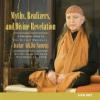| |
 FAQs
about Adi Da & Adidam > Other Traditions FAQs
about Adi Da & Adidam > Other Traditions
Comparisons
with Other Traditions
Questions about how Adidam compares with other religious, spiritual,
or philosophical traditions. This section will become much fuller
over time!
The Uniqueness of the Way of Adidam
 AUDIO AUDIO | 
| The Way That Begins With Realization
length: 07:30
event date: 2004
listens: 2793
Excerpt from the 2 CD set, The Way That Begins With Realization.
What makes Avatar Adi Da’s seventh stage Revelation utterly unique? To find out, listen to this CD set and learn about Adi Da’s singular seventh stage Way as He describes It directly and in the context of other genuine esoteric traditions. These Discourse excerpts are an incredible resource for understanding Adi Da’s seventh stage Way with the guidance of His “map” of the six stages of life, which correlates to the structures of the human being.
Disc 1 is a collection of Discourse excerpts in which Adi Da clarifies His seventh stage Way by distinguishing it from other esoteric traditions.
Disc 2 is a single Discourse in which Adi Da describes the signs and requirements of His seventh stage Way. |
|
|
|
|
 |
|
|
|
|
|
Adi
Da as First, Last, and only Seventh Stage Adept
Question: How can we make sense of Adi
Da's statement that He is "the First, Last, and
only Seventh Stage Adept?"
Brief answer: Shortly
after His Re-Awakening in September, 1970, Adi Da
began a decades-long consideration (concluded finally
in 1993) about whether there had been any other seventh
stage Realizers among all the great Spiritual Masters
throughout history. In this article, we lay out Adi
Da's search for a historical precedent. This consideration
would first lead Him to a greatly clarified set of
criteria for assessing whether the teaching and life
story of a great Realizer or Master indicated that
they were in the seventh stage of life. Ultimately,
it led Him to conclude that He was in fact the first
such Realizer; and further, that, for functional reasons,
He was the first, last, and only seventh stage Adept
— His appearance and work as seventh stage Adept
has opened a "hole in the universe" that now makes
possible endless numbers of seventh stage Realizers.
Having laid out (in this article) Adi Da's criteria
for assessing whether a Realizer is a seventh Stage
Realizer or whether a seventh stage Realizer is also
a seventh stage Adept, any readers of this article
who fully understand these criteria can duplicate
Adi Da's consideration. They can go through the thousands
of Spiritual Realizers in the Great Tradition, apply
these criteria to the teaching and life story of each
Realizer, and confirm Adi Da's conclusions for themselves.
|
|
|
|
|
|
|
 |
|
Adidam and "New Age" Spirituality
|
|
 |
|
|
|
|
|
Developing a Healthy Ego Before Transcending It
Question: A core part of Adi Da's Teaching is about the transcendence of egoity. A common "New Age" notion I have heard is that one must develop a "healthy ego" before one can transcend the ego. What does Adi Da say about this?"
Brief answer: Adi Da has explicitly criticized this view many times. In fact, the difference between this view and Adi Da's is largely a matter of semantics, not substance: what exactly is meant by the word, "ego". In conventional language, "ego" or "self" is used rather confusingly, with both negative and positive connotations ("self-obsessed", "self-centered", etc. vs. "self-esteem", "self-worth", "self-love", etc.) It is that semantic conflation that is largely the basis for the notion that one must develop a "healthy ego" (i.e., develop "self-esteem", "self-love") first before we can transcend the ego (and qualities like "self-centeredness", etc.)
Adi Da uses "ego" and "egoity" in a very specific, technically precise manner, based on His complete awareness of the nature of egoity and the process for transcending it. In Adi Da's view, egoity is not a "thing" or "structure" (that can be "healthy" or "unhealthy") but an act — an act of self-contraction, a separative act — that is superimpossed on the body-mind (and all its functioning) in every moment, creating a contracted, fearful body-mind rather than a free body-mind, happy and fearless in its felt connection to its Divine Source (because it is not separating from the Divine via egoity).
|
|
|
|
|
|
|
 |
|
Adidam and Sixth Stage Traditions
|
full page link If video won't play in place, refresh the page and try again. Or you can click "full page link" (above). | length: 19:38
Adi Da Samraj responds to a question from devotee Ruchiradama Nadikanta while she speaks about the The Heart of Awareness: A Translation of the Ashtavakra Gita (Shambhala Dragon Editions) , a text within the sixth stage tradition of Advaita Vedanta. , a text within the sixth stage tradition of Advaita Vedanta.
Adi Da (at 2:30) clarifies the distinctions between the first six stages of life and the seventh stage Realization. He focuses on the distinction between the most advanced Realization of the sixth stage of life, sixth stage Sahaja Nirvikalpa Samadhi, and the seventh stage Realization. Sahaja Nirvikalpa Samadhi is demonstrated by Ramana Maharshi, for example, and suggested by texts such as the Ashtavakra Gita , the Ribhu Gita , the Ribhu Gita , and the Tripura Rahasya , and the Tripura Rahasya (all mentioned by Adi Da in this clip) which Adi Da calls "premonitory" relative to the seventh stage of life. Sahaj Nirvikalpa Samadhi differs from the less advanced trance samadhis of the sixth stage in that one recognizes conditional existence as arising in the Self, and one can function in the world open-eyed. Even so, there is still a separation between Self and world. The seventh stage Realization is signalled by the regeneration of Amrita Nadi, and the complete dissolution of any difference between Consciousness and Its Radiance. Consequently, the lifetime of the seventh stage Realizer is signed by a progressive Outshining of conditional existence that goes through four stages: Divine Transfiguration, Divine Transformation, Divine Indifference, and Divine Translation. (all mentioned by Adi Da in this clip) which Adi Da calls "premonitory" relative to the seventh stage of life. Sahaj Nirvikalpa Samadhi differs from the less advanced trance samadhis of the sixth stage in that one recognizes conditional existence as arising in the Self, and one can function in the world open-eyed. Even so, there is still a separation between Self and world. The seventh stage Realization is signalled by the regeneration of Amrita Nadi, and the complete dissolution of any difference between Consciousness and Its Radiance. Consequently, the lifetime of the seventh stage Realizer is signed by a progressive Outshining of conditional existence that goes through four stages: Divine Transfiguration, Divine Transformation, Divine Indifference, and Divine Translation.
For more about samadhis like sixth stage Sahaja Nirvikalpa Samadhi, click here and here. |
|
|
Adi Da's "Seven Stages" Framework:
Spiritual Traditions and Esoteric Anatomy
 AUDIO AUDIO | 
| Myths, Realizers & Divine Revelation
length: 04:21
event date: November 25, 2004
listens: 5044
On November 25, 2004, at Adi Da Samrajashram, one of Adi Da's devotees asks Him: "Is there any way to know . . . what is the relationship of ancient Realizers to the traditions that they were associated with?"
Avatar Adi Da responds by illustrating the process of myth-making around Realizers, both in ancient and modern times. He explains that, regardless of what is historically true of any Realizer, any tradition can be understood in terms of the underlying structure of the human being. Throughout the Discourse, Adi Da makes use of examples from numerous traditions including Buddhism, Hinduism, Judaism, and Christianity.
Adi Da: "Traditions do not really depend on there having been an historical individual, whether or not there was one. They can nonetheless still be understood in terms of the structure of the psycho-physical anatomy. And the psycho-physical anatomy, not mythology extending from it, but the psycho-physical anatomy itself — and this is My Instruction to you, to all — that structure itself determines what is regarded to be religious truth, or esoteric truth. Underneath it is a structure, not merely Truth. That structure must be transcended, or there is not Truth Realized."
In this excerpt, Adi Da specifically talks about the Christian tradition, and the importance of distinguishing a "faith" (or system of beliefs) from factual observations of phenomena throughout recorded history.
The full Discourse is now available on the 2-CD set, Myths, Realizers, and Divine Revelation. |
|
| |  |
|
| | |
|
Adidam and Postmodernism
Question: How does Adidam compare with postmodernism?
Doesn't postmodernism reject the view that there is
an ultimate Reality? Isn't Adidam oriented around
the view that there is an Ultimate Reality?
Brief answer: Adidam is a post-postmodern
tradition. Like postmodernism, Adidam rejects all
egoic viewpoints as limited. But this is because it
identifies the ego as the source of all limited
viewpoints (which postmodernism fails
to do). The immediate (and profoundly consequential)
implication is that there is a Viewpoint that is not
limited: if one transcends the ego perfectly, then
"limited viewpoint" is also transcended in the Prior
Unity that is revealed. Thus, unlike postmodernism,
Adidam claims that there is a Prior Unity, and an
ego-transcending (non-separative) Viewpoint associated
with the Consciousness that is that Prior Unity. Adidam
also provides a means for Realizing that Consciousness
(and Prior Unity) directly (not merely "knowing" it
egoically, or forming limited viewpoints about it),
and consequently, for transcending egoity altogether and all the limited points of view so greatly criticized by postmodernism.
|
| | |
|
| |  |
|

|
 | |


186,104 people have liked our site's pages and shared them with their Facebook friends - Most Shared Pages
© 2025 Copyrighted materials used with the permission of The Avataric Samrajya of Adidam Pty Ltd, as trustee for The Avataric Samrajya of Adidam. All rights reserved. None of these materials may be disseminated or otherwise used for any non-personal purpose without the prior agreement of the copyright owner. ADIDAM is a trademark of The Avataric Samrajya of Adidam Pty Ltd, as Trustee for the Avataric Samrajya of Adidam.
Technical problems with our site? Let our webmaster know.